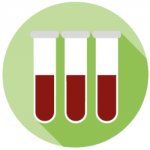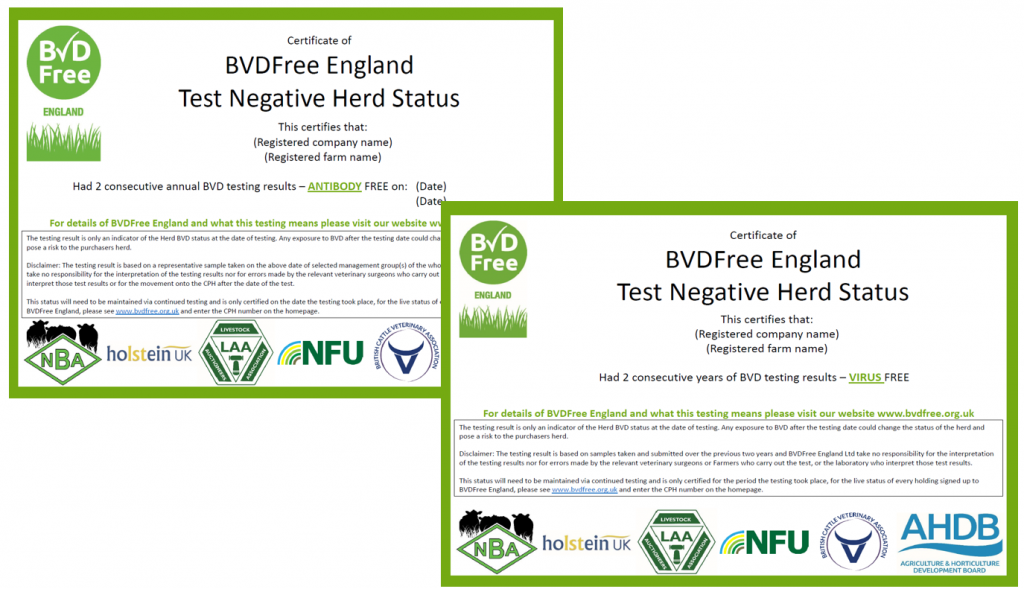About The Scheme
The first step of the BVDFree Scheme is for farmers to sign up to the scheme. The next step is to set up a BVDFree plan on farm using the ‘ADAM’ principles below. By working with your vet and following this guidance, your herd can become and stay free from BVD.
When submitting BVD samples for use in the scheme, samples must be sent to a BVDFree designated laboratory with a completed BVDFree submission form. Each type of test and company has different requirements for send in times and storage, please consult with the provider.
The designated laboratories will upload your results to the BVDFree database. Individual animal status can then be searched by entering the animal’s UK number into the searchbox. Herd BVD status can also be searched by entering the CPH on the homepage. This allows BVD status to be easily accessible when buying and selling cattle.
ADAM (the process of BVD control on-farm)
The key to the elimination of BVD is through the identification and removal of persistently infected (PI) animals.

Bulk Milk Testing
In herds that are actively controlling BVD it is still recommended to use bulk milk antibody tests to monitor status where appropriate. However, due to the complexity of interpreting an antibody response in the presence of vaccine use and historic infection, the test is not included in the BVDFree testing choices. Bulk milk testing can still be a valuable tool to monitor status with careful veterinary interpretation on a case by case basis.
How to Establish BVD Status
Testing
All samples must be sent to a lab designated by BVDFree.


Tag and Test
If you opt to tag and test, all calves born in the herd should be tested for virus by tissue sample, within the year. You can test the calves as they are born or all at once. It is up to you to declare that all calves born within a calendar year have been tested. You must test all calves that are registered as born on your holding. It is also advisable to test any aborted foetuses, stillborn calves and animals that do not produce a live calf or abort a foetus to ensure these are not persistently infected.

Youngstock Blood Sample (Check Testing)

Whenever possible use option (a) below. Where this is not possible, perhaps as a result of animals leaving the herd before the age of nine months, then options (b) and (c) should be followed in order. Before deciding to do a check-test, speak to your vet to identify how many groups to sample in your herd. If you calve twice per year you may need to test your herd twice per year. Your vet will decide how many animals need to be tested and can advise on how best to test herds with very low numbers of cattle.
(a) Five calves aged 9–18 months
Take samples of blood from at least five unvaccinated calves, aged 9–18 months from each separate management group (see below for more information). If you have less than five animals in this age group you should test all of the animals in this category and count them towards the sampling quota in options (b) or (c) as appropriate.
(b) Five calves aged 6–18 months
If less than five of your unvaccinated calves are aged 9–18 months, then sample all of the calves in that age range. Plus take a sample of blood from at least five calves in total including animals in the age range 6–18 months, sampling a minimum of five calves in each separate group. If you have less than five animals in this age group you should test all of the animals in this category and count towards the sampling quota in option (c).
(c) Five homebred animals including animals over 18 months
If you have fewer than five unvaccinated calves aged 6–18 months, then and only then, and on your vet’s advice, you may choose to use the following method: blood sample all calves aged 6–18 months, and in total at least five animals should be tested including animals over 18 months that have been on the holding since birth, sampling a minimum of five animals in each separate group. If you have less than five animals that have been on the holding since birth, test all animals in this category. Discuss with your vet whether tag and test would be a more appropriate sampling strategy for your breeding herd in future years.
1 in 5 Positive Test
Where in any young stock group there is only one antibody test positive sample, it is advisable to bleed the same animal again along with at least five other animals in the group at an interval of no less than 30 days. If no other animals have seroconverted, and the vet has reviewed biosecurity, the vet may submit a request to BVDFree to review the annual test status.
Vaccination
Vaccination helps protect your herd from disease. While vaccination may reduce the impact of BVD, it is important to understand that vaccination alone will not eliminate BVD either from a herd or nationally. Persistently Infected cattle are so highly infectious they will continue to spread BVD even if the herd is vaccinated.
The vaccines available are very effective, but, it is vital that the vaccine is administered exactly as directed in the manufacturer’s instructions. Vaccination is recommended before breeding. Your vet can advise you on how to store, handle and administer the vaccine the vaccine correctly. It is important to use the right dose rates at the right time, including timing of boosters, to get the best results from vaccination. If you don’t follow the instructions your herd will not be properly protected. PI animals shed huge amounts of virus and present a significant challenge even to vaccinated animals. Inadequately vaccinated animals in contact with PI cattle are at significant risk.
BVD virus vaccination is designed to protect cows and heifers in early pregnancy to avoid infection and the production of PI calves. Vaccination before they go through a market or to a show may also useful to protect susceptible cattle if the recommended course of vaccination has been completed in time. A decision on whether, what and when to vaccinate is best taken together with your vet. In considering whether to vaccinate you should consider the risk factors for BVD infection for the herd involved, such as:
- Are there neighbouring holdings with cattle?
- Is there nose-to-nose contact with neighbouring cattle?
- Does the keeper buy-in cattle or is it a closed herd?
- Are bought-in cattle of known BVD status?
- Are cattle sent to shows?
- Are bulls brought in for breeding and is their
- BVD status known?
Check-test sampling needs to be done BEFORE vaccination, ensuring that the resulting rise in antibodies does not lead to an apparent failure in the check-test.

Milk Testing

The milking herd can be screened for the presence of a PI animal by testing a bulk milk sample cows for BVD virus. Check with your laboratory on the maximum number of cows that can contribute to a bulk milk sample for the BVD virus test. If the herd is too big or if a bulk milk sample tests positive, smaller pools and then individual milk or blood samples will have to be tested to identify the virus-positive animal(s).
Remember that in individual milk sampling there is always a risk of cross-contamination, which should be considered when analysing results. If a PI is indicated from this milk screen, further testing will be required on the animals contributing to the sample to identify it. Individual testing is required for this.
Note that bulk milk PCR is not a requirement for annual monitoring in the BVDFree Scheme but regular milk testing is strongly recommended.
Keep it Out - Biosecurity
A detailed on-farm review carried out by the veterinary surgeon in partnership with the farmer should be completed to identify aspects of management that could predispose to the introduction and spread of infection within the farm and provide recommendations for the reduction of these risks.
Test Negative Heard Status
Once you have a achieved either / a combination of:
- 2 negative consecutive annual check tests
- 2 years worth of negative tag and test testing
You are eligible to apply for test negative herd status. The scheme requires you to do this with your vet, via the online log in or on a hardcopy form. It is a requirement for your vet to be BCVA BVD accredited.

DEFRA - Animal Health and Welfare Pathway - BVD
The Animal Health and Welfare Pathway (the Pathway) was launched in 2023.
The Pathway supports continual improvement in farm animal health and welfare. The Pathway is a partnership – the government is working together on each step with farmers, vets, the wider industry and the supply chain.
Guidance for Farmers
You can get funding for your chosen vet to visit your farm and carry out a health and welfare review as a cattle keeper in England.
A health and welfare review will help you:
- reduce endemic diseases and conditions
- increase animal productivity
- improve animal welfare
BVDFree England supports the pathway as a way to test and tackle BVD on farm.
When your testing has been carried out then you are able to share those results with us as part of your test negative application.
Guidance for Vets
The recommendation from DEFRA for BVD testing within the Pathway review for;
- Dairy – Bulk Milk (antibody or PCR) or youngstock blood serum antibody test (BVDFree would recommend the blood serum antibody test to allow the results to be eligible for either BVDFree England test negative herd status or CHECS).
- Beef – Youngstock blood serum antibody test.
Frequently Asked Questions
We’re always here to help if you have any questions. Please view some of our FAQs below.
Additional FAQs can be accessed by visiting our knowledge base or contacting us.
How do I know whether my lab is a designated laboratory?
A list of BVDFree designated laboratories is available here.
Which animals need to be tested?
Dairy (you can download a flow chart with more details from the web page ‘The Scheme’)
- Youngstock – Tag and test all calves at birth for BVD virus OR blood sample 5 – 10 calves, aged 9 – 18 months for BVD antibody (minimum 5 per separately managed group)
- Milking herd – Bulk milk BVD antibody and/or first lactation pooled milk BVD antibody and/or bulk milk BVD antigen test for virus
Beef (you can download a flow chart with more details from the web page ‘The Scheme’)
- Youngstock –Tag and test all calves at birth for BVD virus OR blood sample 5 – 10 calves, aged 9 – 18 months for BVD antibody (minimum 5 per separately managed group)
- As calves are closely mixed with their dams, it is optional to test breeding cows in beef suckler herds. Testing breeding bulls before mixing with the herd is recommended.
All calves born in other types of herd must be tested shortly after birth (eg finishing units)
What happens if I have a PI – does this mean I cannot trade?
PI animals are highly infectious and should be culled as soon as they are identified. PI animals should not be traded. Members of BVDFree agree not to move Persistently Infected (PI) animals other than directly to slaughter (or through a dedicated red slaughter market). Other cattle in your herd may be transiently infected, although can be traded if not identified as a PI. Spreading the BVD virus through movement of the animal puts other herds at risk and undermines the national effort to eliminate BVD virus from England. Knowingly selling an infected animal may also be in breach of the Sale of Goods Act.
How are bulk milk Ab or PCR lab results to be displayed - or are they not going to be displayed?
We are currently working on how results will be displayed for herds from 2017. One proposal is to display along the following lines:
12/345/6789 – from 01 July 2016 to date
10 of 11 tissue antigen (virus) results negative
7 of 10 blood antibody results negative
0 of 1 bulk milk antibody results negative
0 of 0 bulk milk antigen (virus) results negative
After July 1 2016 this would default to test results available for the last rolling 12 months.
If a calf is positive for BVD virus is the dam also a PI?
If the calf is positive on test for BVD virus it is strongly recommended to test the dam as she may also be a PI. If a cow is PI then all of its offspring will also be born persistently infected with BVD virus. If testing shows the dam to be PI then all offspring and descendants of that animal are considered to be PI and may not be sold (except directly to slaughter or through a slaughter-only market) without a negative test result.
How do I access my test results?
Your laboratory will send you a copy of all your test results. If you have joined BVDFree you will have agreed to report all BVD testing results from your herd to the national database. Your laboratory will upload your results to the BVDFree database.
The test results and the herd status and individual animal statuses are openly accessible through the BVDFree database – see home page (without any specific details of farm name or keeper shown). All farmers can check if their results are on the database by searching by ear tag number or CPH number.
Can my veterinary practice have access to my results as well?
It is important that your veterinary practice has access to your test results to ensure that you get the best possible advice and assistance for your herd. As well as alerting your veterinary practice when you first join the scheme, your veterinary practice can check if their results are on the database by searching by ear tag number or CPH number.
What do the different BVD Status's mean?
- BVD Virus Test Negative – cattle are not pregnant and are either: from a BVD accredited-free herd through a CHeCS cattle health scheme OR individually tested BVD virus-free
- BVD Low Risk – from a herd with a ‘negative’ BVD herd status through animal screening OR pregnant cattle that would otherwise be in the above category
- BVD Status Unknown – all cattle not in the above two categories (including from ‘not negative’ herds)
- BVD Virus Test Positive – all cattle for which the most recent BVD antigen test is positive. Animals subsequently retested as BVD antigen negative can be reclassified as BVD Virus Test Negative.